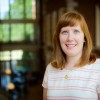This article is more than 5 years old.
The Society of American Archivists’ annual meeting has come and gone!
This year’s meeting was different from past meetings: it was held in a mid-tier market, Portland, Oregon, as opposed to a huge one (last year was Atlanta, next year is DC); it was also the second-largest meeting in SAA history, with a bit over 2,000 attendees; and most of the sessions that I attended were discussion-focused, including the day-long, first-ever Liberated Archives forum, aimed at helping us “envision and implement a community-based approach to archives.” Also, Tanya is now President, so I better remember to read her columns on the blog and in the newsletter.
It was an unusual meeting for me, as well, as I had responsibilities almost every day. I arrived Tuesday morning and in the afternoon, sat on a small panel with Audra Eagle Yun (formerly of this fine institution, now at University of California at Irvine) and a government archivist. The three of us did a mock interview with three ARL/SAA Mosaic fellows, who receive financial support, internship opportunities, and career and leadership resources (such as this panel!). I loved spending time with these three exceptional women, providing some insight into the job hunt and interviews, and connecting with them across the conference week.
My other responsibilities for the week were more standard: on Wednesday and Friday, I helped facilitate Section meetings within SAA. I am now the Chair of the Collection Management Tools (CMT) Section and entered my second year on the steering committee for the Issues and Advocacy Section. I have some new ideas about resources that CMT can provide to archivists, so I’m very excited to get started. Also on Friday, I helped lead the session “Preserving the Spark: Challenges in Archiving Activist Movements.” We aimed to get people thinking about what they have, are, and can do within their personal, institutional, and even professional constraints to support and document activists and their work. Much of the time was spent in small groups, but opening and closing activities helped people get in a useful headspace and consider what they can do post-SAA. We received good feedback, always nice to provide useful support to fellow archivists.
Most of the sessions that I attended spurred me to think critically about my outlook and practices. “Document, Protect, and Mitigate: New Perspectives on the Role of Archives and the Natural Environment” had a lot of such moments; how can we be more thoughtful in the creation and preservation of digital objects, given the immense resources needed to power and cool the so-called cloud? How are we applying “traditional knowledge” to current problems, and how are we documenting that traditional knowledge?
The session “Radical Empathy in Archival Practice,” was based on the Caswell and Cifor 2016 article, “From human rights to feminist ethics: Radical empathy in the archives.” Panelists argued that archivists have five affective relationships: archivist to record creator, records subject, user, community, and each other. The session’s speakers pushed attendees to think about practicing empathy in relation to ourselves, records creators and collectors, colleagues, collections placed behind paywalls, communities that we attempt to serve, etc; group discussion allowed people to speak about their experiences with issues that affect, for better or worse, their ability to practice radical empathy. If you’re curious about any of the above, let’s chat – I’ll be thinking on these subjects for years, possibly.
The rest of my meeting centers on informal connection, often over meals – with friends from graduate school who do similar or very different work from me in their day jobs; CMT’s intern, a museum registrar/archivist who has a lot of enthusiasm; a friend/metadata librarian/archivist who is in the process of implementing ArchivesSpace; a squad of Archivists and Archives of Color Section members; and my favorite, a meal with folks that was set up through the Lunch Buddies program. Anyone can set a Lunch Buddy session via a shared spreadsheet, so the only requirements are (1) thinking of an idea (2) posting it. In my experience, a mix of new faces and old friends have attended, so it’s low-stress. Lastly, my archivist pals Amanda and Pablo brought their very sweet and patient 7-month-old to Annual. Salvador gamely let me hold him during a session and in exchange I let him use my thumb as a teething ring, seemed only fair.
All in all, a great meeting with even more new archivist and archives-adjacent friends made – dealing with the three-hour time difference was totally worth it! And if you’ve read this far, my apologies for not being as funny as Jeff.

7 Comments on ‘SB at SAA 2017’
SB- You were as funny as Jeff! (good report)
Great wrap-up post! Salvador sounds adorable! 🙂
I always find it amazing that we can be in the same place for the same reason, yet have completely different experiences! Sounds like you had a great time (as did I)- thanks for sharing.
Smart plan to read Tanya’s columns! I’d love to hear more about radical empathy some day.
I had no idea you were so involved in SAA! It sounds like you had an amazing conference and yes, let’s talk about radical empathy some time!
Great post! I’d love to chat about radical empathy sometime!
Sounds like you had an excellent conference!